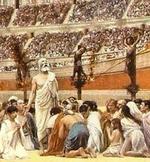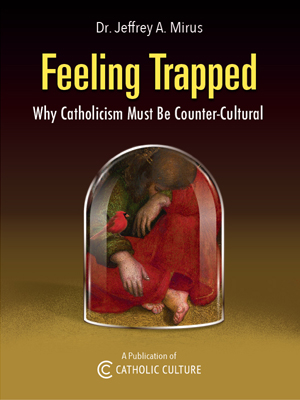The Didache Bible Is Here
By Dr. Jeff Mirus ( bio - articles - email ) | Jan 21, 2015 | In Reviews
I already mentioned the new Didache Bible, before it was actually available, in Two beautiful books to give as Christmas gifts. But I definitely want to call it to your attention again now that you can purchase it. It’s a brand new Bible developed and published jointly by the Midwest Theological Forum and Ignatius Press.
This Bible uses the Second Edition of the Catholic Edition of the Revised Standard Version, widely regarded as the best translation available today. This means it was last revised according to the principles promulgated in Liturgiam Authenticam in 2001. The printing is well done—clean, clear and easy to read—and the accompanying commentary and additional resources are superb. However, the prospective reader needs to realize that this edition’s resources are primarily devoted to highlighting and clarifying the teachings and practices of the Church as found in the Word of God and as more fully articulated in the Catechism of the Catholic Church.
This purpose was inspired by the Midwest Theological Forum’s Didache Series of religious education textbooks, and it makes this edition of the Bible the best one to use in connection with religious education, or by readers who want to understand both the teachings of the Church and their foundations in Sacred Scripture. It would not be the best edition for those who know Catholic doctrine very well and are now interested in exploring the origins and development of the Biblical books, the surrounding history with which the texts interact, or the full range of perspectives on the meaning of difficult passages.
The Didache Bible includes the following preparatory resources as front-matter:
- Foreword by Cardinal Francis George on the general relationships among the Catechism, Vatican II’s Dogmatic Constitution on Divine Revelation, and Sacred Scripture.
- Preface by Fr. James Socias of the Midwest Theological Forum on the fundamental purposes of this edition.
- Introduction on Biblical inspiration and the various senses of Scripture.
- A brief guide on how to read the Bible.
- A brief summary of the major themes of all the books of the Old and New Testaments.
- A chronology of the Old Testament.
- A chronology of the New Testament.
- A thematically-organized list of Scripture passages for personal meditation.
Of even greater interest are the resources which accompany each of the books. There is a one-page introduction to each book which covers authorship, dating, audience and main themes. Then, page by page as the the Biblical text unfolds, we find:
- Extensive commentary, verse by verse, on the meaning of the text and its significance for understanding Catholic teaching and practice.
- Call-out boxes which briefly highlight key Biblical and theological concepts to aid the reader in understanding the full significance of the text.
- Lists of related Biblical passages (these cross references visually separate the text from the commentary).
- Periodic full-page apologetical explanations of important Catholic concepts, teachings and practices, placed at appropriate points along the way. There are over 100 of these longer explanations.
Finally, following the last book of the Bible, the back-matter includes:
- 24 full-color maps providing geographical orientations for both the Old and New Testaments.
- A 44-page glossary of Biblical names and terms.
- Index to the maps.
- Index of apologetical explanations by title.
- Index of apologetical explanations by subject.
- A 23-page index of subjects, including Biblical names, which leads to the Biblical passages in which they appear.
I've attached two rough, home-made double-page scans. One shows pages from the Book of Genesis as an example of the presentation of the text, the Biblical cross-references, the extensive commentary, and the boxed highlights. The other shows pages from the Book of Revelation as an example of how an apologetical explanation (on the Rosary) interfaces with a page of text (again with its characteristic chapter and verse numbers, subtitles, cross references and commentary).
The Didache Bible is currently available in a sturdy hardbound edition with two ribbons. I give this Bible my highest recommendation for all those who wish to understand both Sacred Scripture and Catholic teaching more fully, including the deep links between the two. I would say it is the best edition to give as a first Bible to Catholics who have not yet made an extensive study of their Faith. It is the ideal Bible for them to have when they go off to college or out into the world, where they will eventually be challenged—not least about the relationship between Sacred Scripture and the Catholic Church.
I have provided our usual Amazon link below, but the Bible is currently on sale directly from Ignatius Press. Unfortunately, as of this writing, the Bible is available on Amazon only through third-party sellers, and they come and go, so the Amazon link will not always lead to an available product. Note that Ignatius will release a deluxe leather-bound edition of this Bible at some point within the next two months.
All comments are moderated. To lighten our editing burden, only current donors are allowed to Sound Off. If you are a current donor, log in to see the comment form; otherwise please support our work, and Sound Off!
-
Posted by: lak321 -
Jan. 11, 2017 9:19 AM ET USA
Why do you assume Fr Z would come to that conclusion? Many bishops have stated 'no change, so I assume many Fr Z's will do the same. They may encourage Mr. Doe to attend Mass, to make spiritual communions, to pray for his wife amd that perhaps they may be able to accept livimg together as brother and sister. This is a beautiful path with many graces. That is what I would like done unto me, rather than the easy way.
-
Posted by: Randal Mandock -
Jan. 10, 2017 12:38 PM ET USA
Nice analysis. We need more thought experiments like these. If we can't extract any concrete examples from the Vatican, then we'll have to make up hypotheticals ourselves.
-
Posted by: ElizabethD -
Jan. 10, 2017 12:37 PM ET USA
I know the one and only Father Z, he lives in my town, and you have got him all wrong! I think he must have created confusion about his thinking on Amoris Laetitia by the "Cardinal Kasper Will Accompany Me" parody song he posted recently.
-
Posted by: ForOthers8614 -
Apr. 10, 2015 3:28 AM ET USA
I have found the 1966 Jerusalem Bible's footnotes and cross referencing to be most enlightening. Avoid the bricks whose bindings fail and get the vellum, leatherette covered edition. The castrated New Jerusalem Bible lost the poetic, poignant translation contained in the 1966 edition wrought by such greats as J.R.R. Tolkien. (e.g. Micah 6:8 in the N.A.B contrasted to the J.B.)
-
Posted by: Jeff Mirus -
Jan. 23, 2015 9:37 PM ET USA
To Patrick1933 and wojo425627: To explore the full range of interpretive possibilities, of course, one would have read a number of different studies of each book of the Bible, but in considering an edition of the Bible that does the best job of providing extensive background and commentary all in one place, the clear winner is the Navarre Bible. It also uses the RSV-CE, but it is a large multi-volume work. It comes in various hardback and paperback combinations, both as individual volumes and sets. They are all available on the Scepter Publications website in the "Bibles with Commentaries" section, and on Amazon. You don't want the "New Testament Compact Edition", and I have not seen the latest New Testament Expanded Edition which apparently adds new commentary drawing on recent Church documents and the Catechism. All the others are the volumes I have used. They also include the New Vulgate (Latin) text, along with the English. To simplify things, if you can afford the whole thing at once, get the 7 volume hardback Old Testament set and the 3 volume hardback New Testament set. The commentaries are more extensive for the NT books, however, and if you will have more than one family member sharing those, you might prefer to purchase the 12 volume paperback New Testament set, in which the different portions of the NT are more easily split up for use by several people at the same time. I have never regretted the money spent on these volumes, or the time taken to go through each one slowly. Highly, highly recommended.
-
Posted by: -
Jan. 23, 2015 6:13 PM ET USA
In your review you state, "[The Didache Bible] would not be the best edition for those who know Catholic doctrine very well and are now interested in exploring the origins and development of the Biblical books, the surrounding history with which the texts interact, or the full range of perspectives on the meaning of difficult passages." Which Bible edition or which books would you recommend for this purpose? Patrick
-
Posted by: wojo425627 -
Jan. 23, 2015 11:42 AM ET USA
Hi jeff, what resources would you recommend for those who are interested in exploring the origins and development of biblical books, the surrounding history with which the texts interact, or the full range of perspective on the meaning of difficult passages(in your words)?








